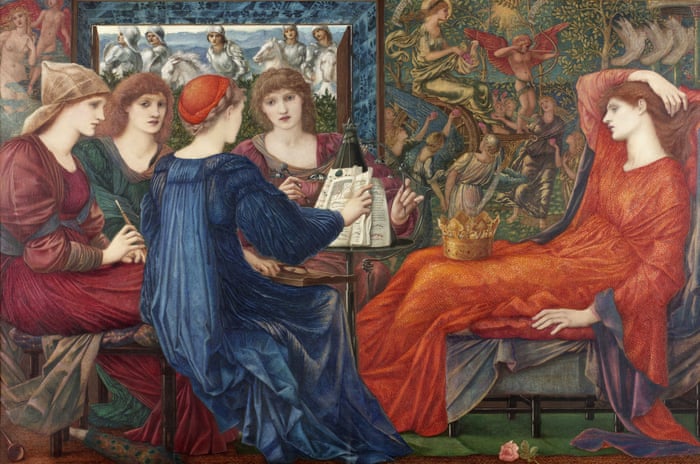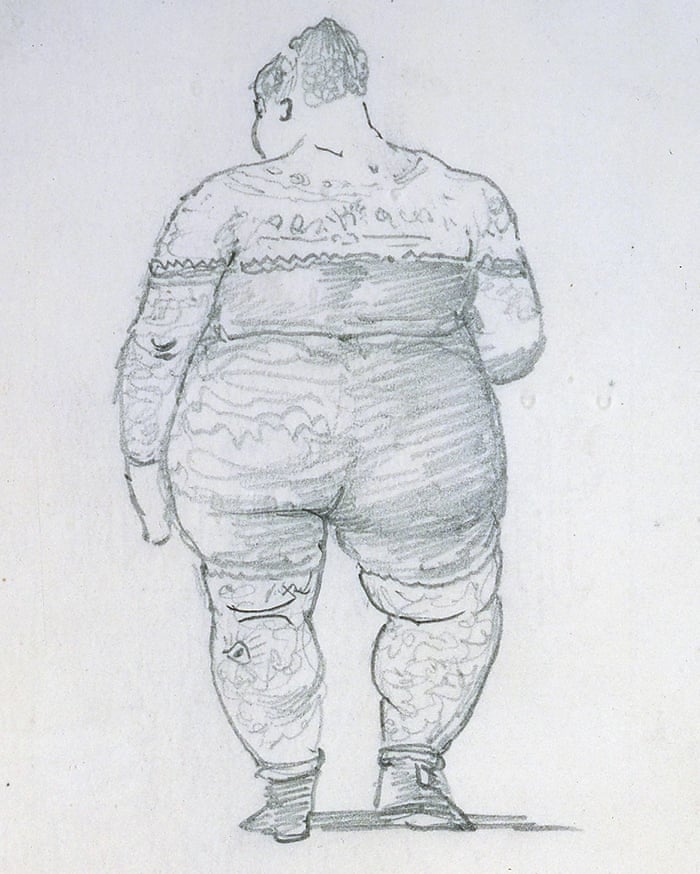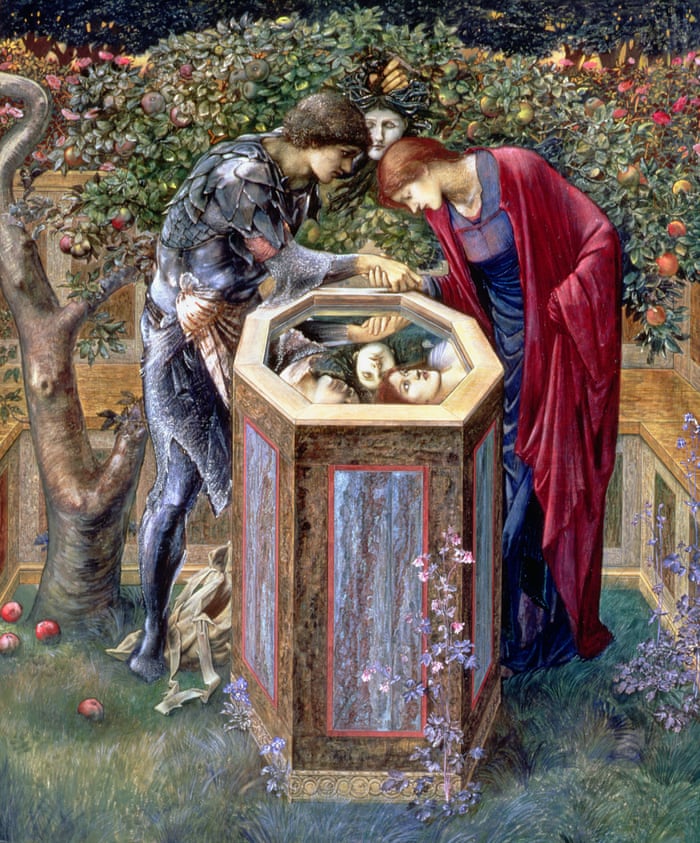
Rossetti’s pupil proves his worth with this vivid masterpiece, inspired by his mistress
Skye Sherwin
The Guardian
Fri 2 Nov 2018
Late bloomer …
Created by the young gun who hung around Dante Gabriel Rossetti’s studio absorbing everything he could, this painting, produced between 1870 and 1873, marks a last great flowering of the pre-Raphaelite style: the plight of illicit lovers; the vivid colours; the hallucinogenic detail. It would soon evolve into the flouncy, morally ungrounded aesthetic movement.
Fri 2 Nov 2018
Late bloomer …
Created by the young gun who hung around Dante Gabriel Rossetti’s studio absorbing everything he could, this painting, produced between 1870 and 1873, marks a last great flowering of the pre-Raphaelite style: the plight of illicit lovers; the vivid colours; the hallucinogenic detail. It would soon evolve into the flouncy, morally ungrounded aesthetic movement.
Greece is the word …
The title is from Browning’s poem but the tragic, lovelorn mood is rooted in Burne-Jones’s own life. The woman is inspired by his former mistress, the Greek heiress Maria Zambaco.
Bad romance …
When he painted this 5ft watercolour-cum-gouache the scandalous affair was over. Their elopement had failed and Zambaco had attempted suicide. She would haunt him for the rest of his life, though, occasionally reappearing in his work as an auburn temptress.
The big money …
In 2013, it sold for £14.8m at auction, almost three times its top estimate and the most ever realised for a pre-Raphaelite work.
Edward Burne-Jones, Tate Britain, SW1 to 24 February

Laus Veneris, 1873-78 (Laing Art Gallery, Newcastle)
Tattooed ladies, quick wit and a mystery affair: the other side of Edward Burne-Jones
He’s best known for his ravishing paintings, but the pre-Raphaelite master also loved dashing off quirky sketches of everyday life – and his tubby friend William Morris
Maev Kennedy
His technique was so painstaking that clients waited years or even decades for commissions to be completed. The drawings couldn’t be more different: rapid-fire sketches of daily life, invented characters such as the fat lady, or wicked little caricatures, including the skeletal figure of the artist himself and his friend William Morris, jovially tubby and about to burst his waistcoat buttons. Many were dashed off in letters that he sometimes exchanged up to five times a day with favourite correspondents, often society ladies with whom his precise relationships remain ambiguous.
His friendship with Helen Mary Gaskell apparently began during a dinner party, over shared hilarity at their memories of a famous American tattooed lady, Emma de Burgh. Both were married, Burne-Jones an art-world superstar in his 60s and Gaskell a bored young wife and society hostess. The exact nature of their relationship is unclear, since at her request Burne-Jones destroyed Gaskell’s letters, but Josceline Dimbleby, her great-granddaughter who has written a book about the odd couple, thinks there may have been more to it than pen-friendship. One letter shows Burne-Jones, head in hands, moaning about how dull the day is without her.
 A Bathing Beauty c.1893–95
A Bathing Beauty c.1893–95
Gaskell and Burne-Jones had both relished seeing De Burgh, who made a good living for decades exhibiting her spectacularly inked skin, turning to reveal the showstopper: the Last Supper tattooed across her back. Burne-Jones drew De Burgh several times, a sturdy but poised and confident figure, and the exhibition will include his drawing made immediately after seeing her at the London Aquarium.
The illustrated letters to Gaskell are on loan from the Ashmolean in Oxford. The museum acquired them at auction – adding to an extensive collection of exquisite Burne-Jones drawings – but hasn’t previously exhibited them. The letters were a surprising inclusion at the Burlington Fine Arts Society in 1899, where his delicately detailed formal studies for finished paintings were compared to Leonardo da Vinci, but the letters were also admired as examples of his “impassioned imagination”.
“There was definitely some shared interest in fat ladies. It was clearly a private joke between them,” said Colin Harrison, senior curator at the Ashmolean, smiling at a drawing showing an imposing figure, evening gown trailing behind her, barely fitting through the door into a lavatory.
Burne-Jones died of heart failure in 1898, and decades later Gaskell gave the letters to a friend, writing: “If you are like me, you will take them out and laugh when you are an old man, as you did the first time you read them.”
He’s best known for his ravishing paintings, but the pre-Raphaelite master also loved dashing off quirky sketches of everyday life – and his tubby friend William Morris
Maev Kennedy
The Guardian
Thu 18 Oct 2018
It was the high-minded and noble Sir Edward Coley Burne-Jones who painted all those armoured knights palely loitering and yearning over wan maidens. It was clearly his scurrilous and much jollier alter ego Ned Jones – his birth name before he upcycled it to a grander version at university – who drew the fat ladies luxuriously dozing in hammocks or sprawled contentedly across chaise longues.
The drawings will go on public display among scores of the pre-Raphaelite artist’s more exalted paintings, in a major exhibition – his first solo show since 1933 – opening next week at Tate Britain. They should delight his admirers, and surprise the many who have been tempted to snap, “Oh pull yourself together man!” in his day – when his graceful male nudes were criticised by some for being insufficiently manly – and ever since.
“The great thing about his jokes is that they are actually funny,” said curator Alison Smith.
The exhibition will include works in stained glass, tapestry and painting, images of a fantasy world that the self-taught Burne-Jones imagined in such obsessive detail that he created full-scale models in his studio of suits of armour, jewels, weapons and even the serpentine monster battled by Perseus.

Thu 18 Oct 2018
It was the high-minded and noble Sir Edward Coley Burne-Jones who painted all those armoured knights palely loitering and yearning over wan maidens. It was clearly his scurrilous and much jollier alter ego Ned Jones – his birth name before he upcycled it to a grander version at university – who drew the fat ladies luxuriously dozing in hammocks or sprawled contentedly across chaise longues.
The drawings will go on public display among scores of the pre-Raphaelite artist’s more exalted paintings, in a major exhibition – his first solo show since 1933 – opening next week at Tate Britain. They should delight his admirers, and surprise the many who have been tempted to snap, “Oh pull yourself together man!” in his day – when his graceful male nudes were criticised by some for being insufficiently manly – and ever since.
“The great thing about his jokes is that they are actually funny,” said curator Alison Smith.
The exhibition will include works in stained glass, tapestry and painting, images of a fantasy world that the self-taught Burne-Jones imagined in such obsessive detail that he created full-scale models in his studio of suits of armour, jewels, weapons and even the serpentine monster battled by Perseus.

The Baleful Head, c1876 (Southampton City Art Gallery)
His technique was so painstaking that clients waited years or even decades for commissions to be completed. The drawings couldn’t be more different: rapid-fire sketches of daily life, invented characters such as the fat lady, or wicked little caricatures, including the skeletal figure of the artist himself and his friend William Morris, jovially tubby and about to burst his waistcoat buttons. Many were dashed off in letters that he sometimes exchanged up to five times a day with favourite correspondents, often society ladies with whom his precise relationships remain ambiguous.
His friendship with Helen Mary Gaskell apparently began during a dinner party, over shared hilarity at their memories of a famous American tattooed lady, Emma de Burgh. Both were married, Burne-Jones an art-world superstar in his 60s and Gaskell a bored young wife and society hostess. The exact nature of their relationship is unclear, since at her request Burne-Jones destroyed Gaskell’s letters, but Josceline Dimbleby, her great-granddaughter who has written a book about the odd couple, thinks there may have been more to it than pen-friendship. One letter shows Burne-Jones, head in hands, moaning about how dull the day is without her.

Gaskell and Burne-Jones had both relished seeing De Burgh, who made a good living for decades exhibiting her spectacularly inked skin, turning to reveal the showstopper: the Last Supper tattooed across her back. Burne-Jones drew De Burgh several times, a sturdy but poised and confident figure, and the exhibition will include his drawing made immediately after seeing her at the London Aquarium.
The illustrated letters to Gaskell are on loan from the Ashmolean in Oxford. The museum acquired them at auction – adding to an extensive collection of exquisite Burne-Jones drawings – but hasn’t previously exhibited them. The letters were a surprising inclusion at the Burlington Fine Arts Society in 1899, where his delicately detailed formal studies for finished paintings were compared to Leonardo da Vinci, but the letters were also admired as examples of his “impassioned imagination”.
“There was definitely some shared interest in fat ladies. It was clearly a private joke between them,” said Colin Harrison, senior curator at the Ashmolean, smiling at a drawing showing an imposing figure, evening gown trailing behind her, barely fitting through the door into a lavatory.
Burne-Jones died of heart failure in 1898, and decades later Gaskell gave the letters to a friend, writing: “If you are like me, you will take them out and laugh when you are an old man, as you did the first time you read them.”









No comments:
Post a Comment